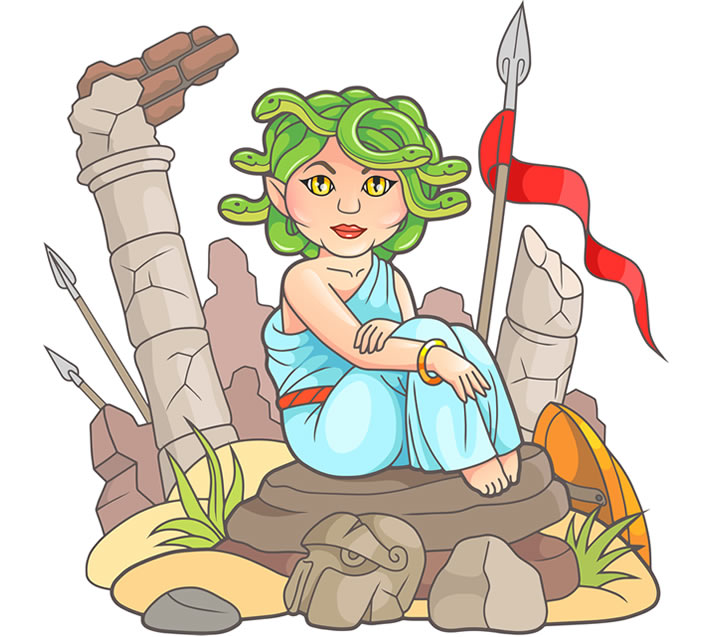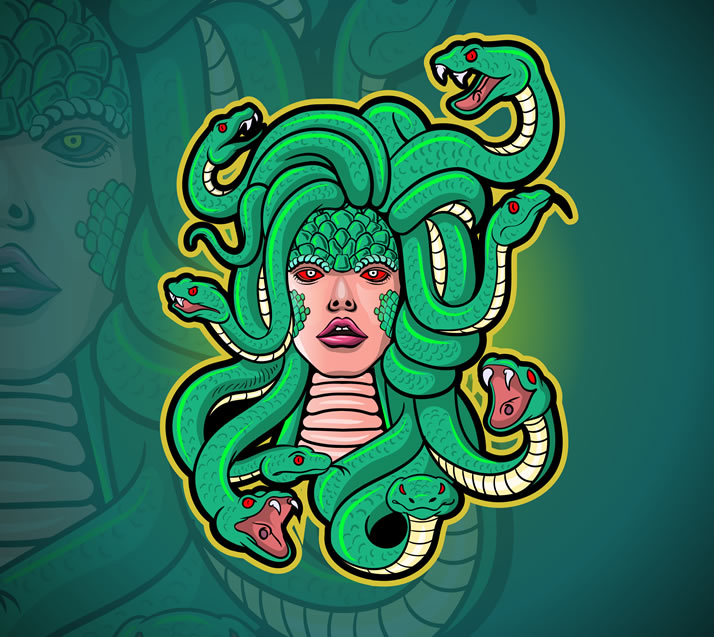Medusa is a famous monster from Greek Mythology who had snakes for hair. In the mythology, it was said that people would turn to stone when they looked directly at her.
She is a tragic Greek character, as she was once a beautiful woman but was turned into an ugly creature by the goddess Athena when Athena punished her for sleeping with Poseidon. Her story ended just as tragically when she met her fate at the hands of Perseus and was beheaded by his sword.

Quick Facts about Medusa
- Medusa was a type of monster called a gorgon, which meant “dreadful” or “grim”.
- She is famous for having a head of snakes instead of hair.
- She was one of the three gorgons, with the other two being her sisters Euryale and Sthenno.
- People would turn to stone if they looked at her.
- Perseus was able to chop off Medusa’s head by looking at her reflection in his shield.
- Medusa was once a beautiful woman and priestess, but was turned into a monster by Athena after sleeping with Poseidon.
- Her name means either “guardian” or “queen”. Euryale’s name can mean either “wide-stepping” or “of the wide briny sea,” and Sthenno means “strength.”
- Medusa was the mother to two creatures by way of Poseidon and Perseus’ sword. While Perseus did not know this, his decapitation caused the two creatures to spring from her body. Those creatures were Pegasus, the winged horse, and Khrysaor, a giant armed with a golden sword and whose name literally means “wielder of a golden sword.”
- Designs based on Medusa’s head were often used as wards. Ornaments featuring this design were known as “Gorgoneion.” Zeus and Athena are the two Olympians most often mentioned as using this specific ornamentation.
Physical Characteristics
Medusa is a monstrous being that is part snake and part human. While most of her form was female, she also possessed wings, tusks and her hair was a slithering cluster of vipers. Some designs on pottery and other artworks depict Medusa and her sisters as horrid creatures; younger designs tweaked things a bit, shaping her snakes and form so she appears pleasing to the eye.

Origin
There are two major origin stories for the creature known as Medusa.
- She was one of three creatures, known as gorgons. Each of these gorgons were equally horrific hybrids of woman and snake but had their own name: Euryale, Sthenno and, of course, Medusa.
- Ovid’s “Metamorphosis” presents a different take. In this story, Ovid claims that Medusa was a gorgeous human woman. In fact, Medusa was so beautiful that Poseidon, Greek god of the sea, was compelled to show his affections for her while within a temple dedicated to Athena. Athena was so insulted by the act that she punished Medusa with the form synonymous with the name “Medusa.”
While most sources claim that the gorgons were the children of Phorcys and Keto, a pair of primordial sea deities, Hyginus’s poetry indicates that her father was an entity known as “Gorgo,” thus making his three sisters the “gorgons”.

Powers and Abilities
Medusa only has three notable abilities.
- Flight. While all three gorgons were given wings, there is little description of Medusa putting hers to work in the one story she features in. It is worth remembering that her sisters also had wings and are described as taking flight after Perseus for killing their sister.
- Snake-Hair.
- The eastern sand/horned viper is mildly venomous but produces a whistling sound prior to striking.
- The coastal/Ottoman viper is about as venomous and hostile as the eastern sand viper.
- The common European adder produces venom that is less severe than the other snake species mentioned so far.
- The meadow adder is even less venomous than the other vipers on this list. Its Greek name translates as “dwarf viper.”
- Petrifying Gaze. Anyone who dared to look directly at Medusa would be turned to stone, petrified in whatever pose they were stuck in-often looks of horror. It should be noted that only looking upon the genuine article caused this response; anyone who stumbled upon a reflected image of this gorgon, even if the mirrored image were staring directly at him, would remain flesh and blood.
While Medusa’s snakes were never used to attack, they are stated to be venomous. Venomous snakes are known as “vipers” and there are several notable species of viper within Greece.
Even if one of these snakes is only mildly venomous, anyone unlucky enough to be in close range of Medusa and unpetrified would likely be savaged by multiple snakes striking at the same time. Exposure to multiple doses of the same strength of a toxin actually results in an increase to potency in those toxins.
Stories or Fairy Tales Involving Medusa
Medusa plays a prominent role in the story of Perseus. In most narratives, Perseus is tasked by King Polydectes to claim the head of Medusa in order to prove his worth. In truth, Polydectes only gave Perseus the task as busywork so that he could pursue Perseus’ mother Danae. Perseus has been collecting various magical items in his quest of heroism and he put many of these to use, including a mirrored shield and a sword hand-forged by Hephaestus, to the task of decapitating Medusa.
As Medusa was the only one of her brood to lack immortality, she was perfectly vulnerable to having her head chopped off with Perseus’ divine blade. Perseus was able to get within slashing range of Medusa by watching her in the reflection of his mirrored shield. As previously mentioned in Powers & Abilities, Medusa’s petrifying gaze only worked on people who looked at her, Perseus was just fine and able to land a blow by following the reflection of Medusa.
Perseus then takes the head as proof of his kill and rides Pegasus back to King Polydectes. After learning the true reason for why he was off on so many heroic side quests, Perseus brandishes the decapitated head of Medusa, whose powers of petrification remained even after death, causing the king and all of his conspirators to be turned into statues. Eventually, Perseus returned the shield to Athena, along with Medusa’s head. Athena accepts the offering and places the fearsome head onto her shield, known as the “Aegis.”
Medusa in Modern Culture
- Medusa shows up in many video games. The decapitated “Medusa Head” has been a staple of the “Castlevania” video game franchise and is an entire species of monster that flies around areas where precision jumping is required, knocking reckless players backward and possibly into a fatal pit. Some of the games feature a golden variant that can petrify characters in addition to the usual knockback effect from making contact.
- One of the stages in the lives of jellyfish is called the “Medusa Stage”. It is during this stage that jellyfish have long tentacles and a hood, in which they certainly resemble the mythical creature in certain ways.
- She appears in the movie “Clash of the Titans”, which was released in 1981.
Sources/References
https://en.wikipedia.org/wiki/Medusa
https://www.theoi.com/Pontios/Gorgones.html
https://www.quora.com/Are-there-any-dangerous-snakes-in-Greece
https://castlevania.fandom.com/wiki/Medusa_Head

























